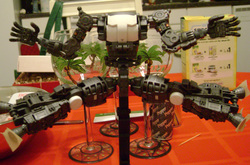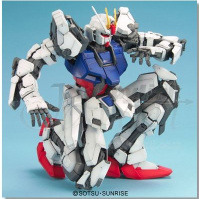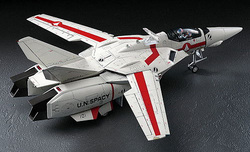Japanese “Mecha” Kits Offer New Dimension on Modeling - By Chris Luna As modelers, we are well aware of what we (and others) like to build. There are the armor builders, the airplane modelers, the science fiction fans, the motor enthusiasts, and the occasional ship builder, but there is one set of science fiction modelers many may not know about, which focuses on Japanese “mecha,” or giant robots and other machines. Japanese sci-fi modeling is very broad, but for this article, the main focus will be on the Mobile Suit Gundam and Macross franchises. “Gundam” and “Macross” sound like nonsense words, but they actually represent some of the longest-lasting and most popular Japanese science fiction animation franchises of the past 30 years, and driving that popularity are scale models from each of those franchises. The model kit ranges are many and diverse, but like any other genre of modeling, they require the same skills and techniques to build and paint them effectively. Spanning over 30 years through one mainline continuity (the “Universal Century”) of TV shows, movies, video releases, and many different unrelated spin-off continuities since the mid-1990s, the Mobile Suit Gundam franchise often revolves around the colonization of space and its conversion into a battlefield fought with “mobile suits,” which are essentially walking tanks, or space fighters with arms and legs. More agile, and more heavily armed and armored than your average tank or fighter, mobile suits form the lifeblood of Gundam’s plots and its model kits. In recent years, manufacturer Bandai-Namco has managed its Gundam releases under a wide array of scales and quality classes for all skill levels. In order to grasp the dizzying variety of Gundam models available, one must understand the skill levels and scales that Bandai has set out for hobbyists. First are the “no-grades.” These 1/100 and 1/144 scale kits usually date back to the 1980s and require paint and glue to complete, which is no mean task for experienced modelers. But the awkward proportions, poor articulation, and cartoonish lack of detail may be seen as a deal breaker or as a challenge to improve on the design, depending on your point of view. There are a few quality exceptions from the earliest lines and many kits from around 1988 or 1989 feature snap construction, relatively minimal paint requirements, good proportions, and decent articulation for the time. Second are “High Grades,” which Bandai launched in the early 1990s, first in 1/144 scale, and then 1/100 scale (averaging around 4”-6” heights). Featuring better proportions, details, snap construction, and requiring little paint for a decent display, these somewhat inexpensive kits form the backbone of the Gundam model line. Kits manufactured before 2000 or so, however, often feature less detail and articulation than modern kits, but Bandai improves upon its designs year by year. Third are “Master Grades,” which Bandai launched in the mid-1990s. Exclusively sold in 1/100 scale (averaging around 7”-8” heights), these larger kits feature greater amounts of detail and equipment. Like their High Grade counterparts, kits manufactured before 2000 lack a lot of articulation and relative detail, but again, Bandai improves upon its designs every year. Most models made after 2000 include highly detailed inner frames that greatly improve articulation and give experienced modelers greater chances to customize their builds. Fourth are “Perfect Grades,” which take the Master Grade template and bump it up a notch or two. Clocking in at 1/60 scale (around a foot tall), these enormous mecha include even finer surface details, and highly detailed and flexible inner frames and other gimmicks like fully poseable hands and light-up eyes and sensors. Launched in the late 1990s, the Perfect Grade line’s innovations have filtered down to Master Grade releases the past ten years. Finally are “Real Grades,” which launched last year and combine the best traits of 1/144 High Grades with those of Master Grades and Perfect Grades, namely the small size of the former and the high detail and articulation of the latter. Only a few releases currently exist, but they represent iconic designs from the Gundam multiverse. The Macross franchise revolves around war with humanoid alien giants, and like Gundam, features giant mecha. Its claim to fame, however, is that its human mecha are aerospace fighters (known as variable fighters) that can transform into giant robot soldiers to go toe-to-toe with said aliens. Also like Gundam, Macross features many different kits and scales (many which can also transform!), but this article will focus on the static display aircraft models released in recent years. Manufactured by Hasegawa, Macross' 1/72 and 1/48-scale planes feature the same quality moldings and details that define Hasegawa’s real-world aircraft kits, but with a sci-fi twist. The standard kit is the “VF-1 Valkyrie” and is available in the standard configuration and the Super/Strike versions, which pack additional weapons and boosters. Also available (in true Hasegawa style) is an optional set of the original series’ signature weapons. Besides the VF-1, other 1/72 and 1/48 Macross planes exist that are exciting departures from real-world aircraft. So how does Japanese mecha modeling stack up to traditional modeling? Surprisingly, they share nearly everything in common. In Gundam modeling circles, customization is not only encouraged, it’s often expected. Don’t let the modern kits’ relatively easy construction fool you, for full paint jobs, custom paint schemes, weathered finishes, battle damage, dioramas, and upgraded details are common to the hobby. Nearly every technique used and encouraged in military and automotive modeling can be (and should be) used for mecha. As for Hasegawa’s Macross kits, their construction is identical to Hasegawa’s real-world aircraft: glue, paint, and steady hands are still required. Creatively, the sky is the limit, and don’t let ignorance of the subject matter intimidate you, for the same techniques for traditional models apply to mecha. If anything, use the box art as references for the environments and climates a particular mecha may face, and think outside the box if you so desire. (A spacegoing unit obviously will weather differently from a ground-based one.) Like traditional modeling, a whole cottage industry of custom upgrade parts exits to take your kits to the next level. So where do you go about finding mecha kits? For starters, HobbyTown often stocks a few in the science fiction aisle, but the internet is the best starting point for poking around. HobbyLink Japan (www.hlj.com) is the world’s premier exporter of mecha kits, and its English-language text and rich image content will make poking around and ultimately making a selection a breeze. Mecha model prices are often comparable to traditional kits, but buyers have to account for overseas shipping. Mecha modeling is a popular, but often overlooked subset of science fiction modeling, but don’t let that distinction fool you. A polished mecha kit requires the same degree of attention as anything else, and they can be an amazing break from traditional builds. Variety is the spice of life, and there is little wrong with stepping a little outside of your comfort zone to try something else. Mecha are perfect for doing just that.
4 Comments
|
Archives
February 2017
|












